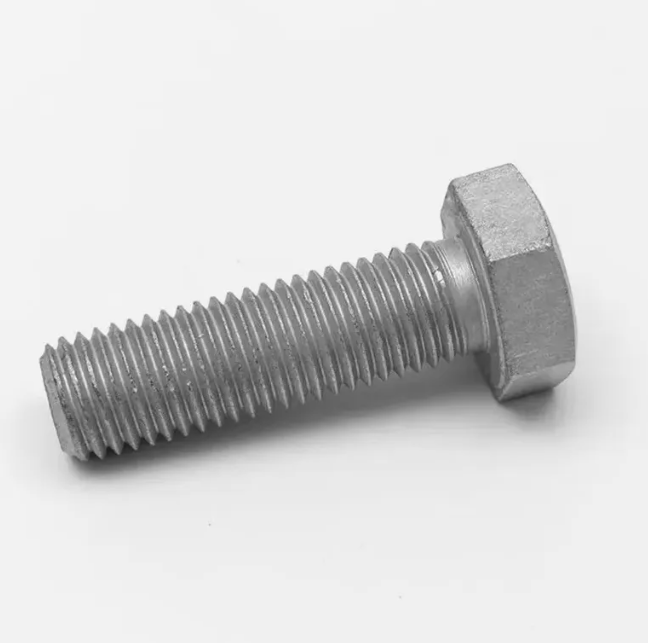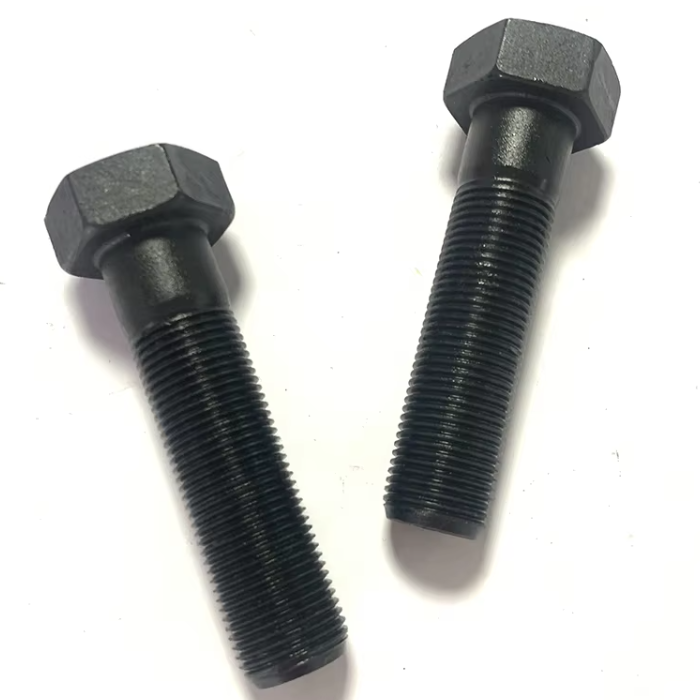Hex bolts are a staple in a wide range of industries, from construction to automotive to machinery. Their simple design and versatile functionality make them a go-to fastener for both professionals and DIY enthusiasts. But what exactly is a hex bolt, and why is it so widely used? In this post, we'll break down the key features, applications, and considerations for using hex bolts in your projects.
What Makes a Hex Bolt Different from Other Fasteners?
What is the Definition of a Hex Bolt?
A hex bolt is a type of fastener with a hexagonal head that is used to secure two or more objects together. The head of the bolt is designed to be turned with a wrench or a socket to tighten or loosen it. The term "hex" refers to the six-sided shape of the bolt’s head, which allows for easy gripping with tools.
While it may seem simple, the hex bolt is essential for many industries. Unlike other fasteners like screws, hex bolts have a full, smooth shank and a heavier design, making them ideal for high-stress applications.
How Does a Hex Bolt Compare to Other Types of Bolts?
When compared to other types of bolts such as carriage bolts or lag bolts, hex bolts are versatile and commonly used for general fastening purposes. Carriage bolts, for example, are designed with a round head and a square neck that prevents rotation during installation, making them ideal for wood but less suited for metal applications. Lag bolts, on the other hand, have a pointed end and are commonly used for wood but not ideal for metal applications where a hex bolt is more reliable.
In terms of versatility and strength, hex bolts stand out as the most common option for a wide variety of fastening needs.
Types of Hex Bolts
Standard Hex Bolts vs. Heavy Hex Bolts
The main difference between a standard hex bolt and a heavy hex bolt is the size and strength of the bolt. A heavy hex bolt, also known as a "heavy hex" or "structural hex bolt," has a thicker body and larger hex head compared to a standard hex bolt. This makes heavy hex bolts more suitable for high-stress applications, such as large construction projects, bridges, and machinery that requires extra strength and durability.
Heavy hex bolts typically come in higher-grade materials and are designed to handle heavier loads.
Hex Head Bolt vs. Hex Cap Screw: What’s the Difference?
Hex head bolts and hex cap screws might seem similar at first glance, but there are key differences. A hex head bolt typically has a thicker shaft and is used when the threaded portion will go into a nut or threaded hole. On the other hand, hex cap screws have a uniform thread and are usually designed to go directly into a tapped hole, meaning they don’t require a nut.
Understanding this distinction is important when selecting fasteners for different applications to ensure the correct fit and function.
The Anatomy of a Hex Bolt: Key Parts You Need to Know
Hexagonal Head
The hexagonal head of a hex bolt is designed to be gripped by a wrench or a socket, making it easier to tighten or loosen. The six sides offer a larger surface area for tools to grab, which means more torque can be applied, making it easier to fasten bolts tightly and securely. This is one of the reasons why hex bolts are commonly used in heavy-duty applications.
The Shaft and Threading
The shaft of the hex bolt is the long cylindrical part that extends from the head and is the portion that goes through materials to fasten them. The threading on the shaft provides the grip needed to secure the bolt.
Threading comes in two main types: coarse and fine threads. Coarse threads are typically used in soft materials and are easier to install. Fine threads, on the other hand, provide a stronger grip and are used in harder materials or when higher strength is needed.
Material and Coatings
Hex bolts can be made from a variety of materials, including steel, stainless steel, and brass, each offering different advantages. Steel hex bolts are commonly used in general applications due to their durability and affordability. Stainless steel bolts are more resistant to rust and corrosion, making them ideal for outdoor or marine environments. Brass bolts, while not as strong, are often used in electrical applications due to their conductivity.
Coatings like galvanized or zinc-plating can further protect the bolts from corrosion, extending their life and ensuring the strength of the fastening.

Applications of Hex Bolts
Common Uses of Hex Bolts in Construction
Hex bolts are commonly used in construction, especially in structural applications. For instance, they are used to fasten beams, frames, and other structural elements. Their strength and reliability make them essential for projects where safety is paramount, such as bridges, skyscrapers, and large industrial buildings.
In construction, the size, material, and grade of the hex bolt depend on the structural requirements and environmental conditions of the project.
How Hex Bolts are Used in the Automotive Industry
In the automotive industry, hex bolts are used extensively in the assembly and repair of vehicles. They secure engine parts, suspension components, and chassis. The strength and reliability of hex bolts ensure that critical vehicle parts remain securely fastened, maintaining safety and functionality on the road.
The automotive industry uses specific grades of hex bolts, depending on the part’s required strength and the operating conditions of the vehicle.
Industrial Applications of Hex Bolts
Industries that manufacture heavy machinery, factory equipment, and large appliances rely on hex bolts to keep everything secure. Whether it's a conveyor belt system or a large turbine, hex bolts hold essential parts together and endure the stresses of high vibrations and loads.
Hex bolts are often chosen for these applications due to their ability to handle heavy-duty demands while maintaining a high level of safety and performance.
How to Choose the Right Hex Bolt for Your Project
Selecting the Correct Size for a Hex Bolt
Choosing the correct size for a hex bolt is crucial to ensure that the fastener holds materials securely without causing damage. Size refers to the bolt’s length, diameter, and the thickness of the materials you are fastening. If the bolt is too short, it may not penetrate deeply enough, and if it's too long, it could cause problems with alignment and strength.
Always measure the materials carefully to ensure the right length and diameter for your application.
Choosing the Right Material for Hex Bolts
The material of the hex bolt plays a significant role in its performance. Stainless steel bolts are ideal for environments where rust and corrosion are a concern, while carbon steel bolts are suitable for general indoor applications. If the bolt will be exposed to extreme conditions, such as high temperatures or corrosive environments, materials like titanium or specialized alloys might be necessary.
Choose the material based on your project’s specific needs and the environment where the bolt will be used.
Determining the Right Thread Pitch
Thread pitch is the distance between threads on the bolt shaft. Coarse threads are better for softer materials like wood, while fine threads are stronger and better for harder materials. The choice between coarse or fine threads depends on the material you are fastening and the load requirements of the application.
Considering Hex Bolt Strength and Grade
Hex bolts come in different grades, which indicate their strength and load-bearing capacity. The most common grades are Grade 2, Grade 5, and Grade 8, with Grade 8 bolts being the strongest and most durable. When choosing a bolt, ensure you select the appropriate grade for your application to avoid premature failure or safety risks.
How to Install a Hex Bolt Properly
Step-by-Step Guide to Installing a Hex Bolt
Select the correct hex bolt size, material, and grade.
Align the parts you wish to fasten.
Insert the hex bolt through the materials, ensuring it goes through the intended holes.
Use a wrench or socket to tighten the bolt, ensuring it is securely fastened without over-tightening.
Check the bolt periodically for any loosening or wear over time.
Common Mistakes When Installing Hex Bolts
Over-tightening: Applying too much torque can damage the bolt or the materials you’re fastening.
Misaligned threads: If the threads are not aligned properly, the bolt may fail to fit or could get stripped.
Ignoring torque specs: Always adhere to the manufacturer’s recommended torque to ensure a proper fit.
How to Maintain and Care for Hex Bolts
Preventing Rust and Corrosion
To ensure hex bolts last longer, regular maintenance is important. Apply anti-corrosion coatings or rust inhibitors to prevent rust, especially in outdoor environments or areas with high humidity. Also, inspect hex bolts for signs of wear or corrosion and replace any damaged bolts promptly.
When to Replace Hex Bolts
If you notice any signs of rust, wear, or damage, it’s time to replace the bolt. Also, if the bolt loosens over time or fails to secure the materials effectively, it should be replaced to avoid structural failure.
Why Are Hex Bolts So Important?
The Benefits of Hex Bolts Over Other Fasteners
Hex bolts are durable, versatile, and provide a secure hold, even under heavy load conditions. They are easy to install and remove, making them a preferred choice in various industries. Their strong design also ensures they hold up well under mechanical stress, making them essential for both safety and functionality.
The Future of Hex Bolts in Engineering and Manufacturing
As technology advances, hex bolts are evolving. Innovations in materials, coatings, and designs aim to improve their strength and performance, especially in industries where durability is critical. For example, hex bolts made from advanced alloys or with self-locking mechanisms are being developed for high-tech applications.
Conclusion
Hex bolts are simple yet vital fasteners in almost every industry. Understanding their components, types, and how to select and install them properly can help ensure that your projects are secure and reliable. Whether you’re working on a construction site, in an automotive workshop, or in industrial manufacturing, choosing the right hex bolt for the job is essential.

FAQ
Q: What is a hex bolt used for?
A: Hex bolts are used to fasten materials together in construction, automotive, and machinery.
Q: How do I choose the right size hex bolt?
A: Choose a hex bolt based on length, diameter, and the materials you're fastening.
Q: What’s the difference between a hex bolt and a hex cap screw?
A: Hex bolts have a thicker shaft, while hex cap screws are used in tapped holes without nuts.
Q: Can hex bolts rust?
A: Yes, hex bolts can rust if not made from corrosion-resistant materials like stainless steel.
Q: How do I install a hex bolt properly?
A: Align materials, insert the bolt, and tighten using a wrench or socket, ensuring the correct torque.





















